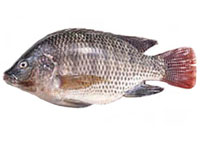Other Introduced Fishes
Oscar
Astronotus ocellatus
| Description | Brightly colored with irregular red markings on a dark brown body; prominent black spot surrounded by red ring at base of caudal fin. |
| Size | Weight reaches 3 pounds or more; state record 2 pounds 6 ounces. |
| Distribution | O‘ahu. |
| Habitat | Prefers quiet shallow water. |
| Feeding | Feeds on small fish, crayfish, worms and insect larvae. |
| Life history | Spawning in Hawai‘i occurs from about March to September; oscar pairs excavate a circular nest in shallow water, where eggs are deposited; both parents guard the nest. |
| Fishing methods | Minnow like lures are effective; live baits include worms, crayfish and mosquitofish. |
| Note | Introduced to Hawai‘i in 1951. |
Pongee (snakehead)
Channa striata
| Description | Dark mottled coloration on top and sides mixing black with yellow-orange, white below; very large scales and slimy to the touch; eel-like in appearance; excellent eating. |
| Size | Adults average 2 feet in length and 3 pounds in weight; largest known to have been taken in Hawai‘i exceeded 5 feet in length. |
| Distribution | O‘ahu; abundant in Wahiawā Reservoir and other reservoirs on the north side of the island. |
| Habitat | Prefers calm near shore waters and will often float with debris; an obligate air breather, it will suffocate if held under the water on a stringer. |
| Feeding | A voracious predator, its feeding habits are similar to largemouth bass. |
| Life history | pawning occurs during the spring and is limited to reservoir or pond habitats; one or both parents will guard the young for several weeks. |
| Fishing methods | Same as for largemouth bass. |
| Note | Introduced to Hawai‘i in the early 1800’s. |
| Warning | Do not put your thumb in fish’s mouth. In addition to the teeth on its jaw, it has large backward-pointing teeth on the roof of its mouth that can inflict deep wounds. |
Puntat (Chinese catfish)
Clarias fuscus
| Description | Coloration ranges from dark green to brown to black; flesh dark red; no scales; excellent eating. |
| Size | Average weight about 1 pound; maximum about 2 pounds. |
| Distribution | Abundant in streams and reservoirs throughout Hawai‘i. |
| Habitat | Reservoirs and lower to middle reaches of streams; a facultative air breather, its presence may be betrayed by small geysers of water that erupt when it surfaces for air; preference for deep water or dark crevices makes it rarely visible to casual observers. |
| Feeding | Worms, insects and carrion comprise the diet of these opportunistic feeders. |
| Life history | Spawning occurs year round under normal conditions; In the event of drought it can survive for weeks in damp mud. |
| Fishing methods | Worms are the favored live bait; artificial lures are ineffective. |
| Note | Introduced to Hawai‘i in the early 1800’s. |
Carp (Koi)
Cyprinus carpio
| Description | Brassy olive above, yellowish on sides and belly in wild form; domesticated koi may exhibit a wide range of brilliant colors; scales large but may vary in form; one variety (leather carp) has no scales; easily differentiated from goldfish by a pair of moderately long barbels at corners of mouth. |
| Size | Weight up to 20 pounds in Hawai‘i; world record 75 pounds 11 ounces (France). |
| Distribution | Present in reservoirs on all islands. |
| Feeding | Omnivorous; root up the bottom when they feed. |
| Life history | Spawn in spring and summer in Hawai‘i; transparent adherent eggs are broadcast or clumped on nearshore substrate; parents do not protect the young. |
| Fishing methods | Doughballs or corn are favored. |
| Note | Introduced to Hawai`i in the 1800’s. |
Tilapia
Oreachromis mossambicus
| Description | The most common of the four species of tilapia deliberately introduced to Hawai‘i; generally a grey to dark coloration; spawning males are black; concave head shape; red fringe on dorsal fin; large scales. Although there is a local prejudice against the fish, it is in fact good eating (depending on the water it is taken from) and is raised commercially in many areas of the world. |
| Size | Average weight about 1 pound; maximum 5 pounds. |
| Distribution | Abundant in reservoirs, lower streams and brackish waters statewide. |
| Feeding | Primarily herbivorous, but also an opportunistic scavenger. |
| Life history | Breeds throughout the year but more intensively during the warmer months; digs nests for spawning; female incubates the eggs in her mouth; at moments of danger the fry continue to take refuge in the mother’s mouth for a week or more after hatching. |
| Fishing methods | Worms and doughballs are effective bait. |
| Note | Introduced to Hawai‘i in 1951. |
